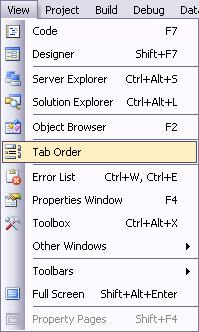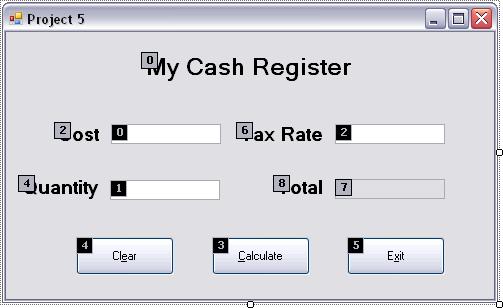Close your last project and creating a new one
If you still have the Project3-4 project open, select the Close Project item on the file menu to close it.
With no open projects, click on the Project... option next to Create: on the Start Page, or pick New Project item on the File drop-down menu.
The Add New Project dialog appears. With the Windows Application template selected, type Project5 for the name and click the OK button. Now click the Save All button on the toolbar to save the project. Be sure to uncheck the Create directory for solution option on the Save Project dialog box. Do not change the default Location path and click the Save button.
This creates a new folder inside the My Documents\Visual Studio 2008\Projects\ folder named Project5:
My Documents\Visual Studio 2008\Projects\Project5
Rename the Form file and the Form
With the form file (Form1.vb) selected in the Solution Explorer window, the Properties window directly below it displays it's File properties. Click on the File Name property and type frmProj5.vb (don't forget to include the .vb extension). To display the properties of the form in the Properties window, click once on the blank Form, which should be displayed on the left side of the screen in the Design window. Make sure the Name property—which is in parentheses (Name) at the top of the property list so that it's easy to find—is frmProj5. Then scroll the properties windows down and change the Text property to Project 5.
Before going on, click on the Save All
button on the toolbar to save your project.
Creating a custom Cash Register
Here’s your chance to use what you have learned. This program will simulate a simple Cash Register. On a blank form you will place 4 Textboxes: One each for Cost, Quantity, Tax Rate, and Total Price. Each Textbox will be labeled with a Label control. Labels are one of the simplest Controls of all. Labels come with Event Procedures like other controls, but it’s rare that you’ll ever use them. All you’re going to use Labels for in this program is to label your Textboxes. Besides the 4 Textboxes, and 4 Labels, you’re also going to add 3 Buttons. One Button each for Clear (to clear the contents of the Textboxes), Calculate (to calculate the Total price from the Cost, Quantity, and Tax Rate), and Exit. Oh, and don’t forget to add one more Label as a title. Below is an example of the program, but you do not need to copy this layout exactly. Besides containing the essential Controls shown, you can make it look any way you like:

Following are 3 sections which provide 3 levels of help designated: Hacker, User, and Nubie.
- The Hacker level is the hardest, with the least amount of instruction—you’re pretty much on your own. For those of you who like to figure it out for themselves, try the Hacker help section first.
- The User help section is for those who like to figure things out for themselves, but need a little extra information.
- The Nubie help section (which is computer slang for beginner) is more instructive than Hacker or User and might give you that one hint that gets you moving when you get stuck.
Please try to figure out as much as you can on your own. Begin with the Hacker help section and only refer to the User and Nubie help sections when you get stuck. When you finish with the basic project, don’t forget to try and complete the Required Enhancements at the end.
Hacker Help Section
I have only a few important suggestions:
- Follow the proper naming conventions for your Controls, and Variables that you were using in the first 4 projects.
- To make the Total value appear as currency, investigate the Format function in Visual Basic Help.
- Don’t try and make this program more complicated than it needs to be.
User Help Section
First read the instructions in the Hacker help section above.
Here are the commands to calculate the Total as they should appear in the btnCalc_Click event procedure:
‘Dimension a Double variable to hold the
' calculated Total.
Dim dTotal As Double
‘Calculate the total amount
dTotal = Val(txtCost.Text) * Val(txtQuantity.Text)
‘Calculate the Tax and add it to the total
dTotal = dTotal + (dTotal * Val(txtTaxRate.Text))
‘Format the total as currency and copy it
' to the txtTotal textbox.
txtTotal.Text = Format(dTotal, "Currency")
Get Help on the Val and Format functions to understand what they do.
Here’s a hint for the Clear button. Textboxes have a Clear method, like so:
txtCost.Clear()
This command erases any previous value in the Text property of the txtCost textbox control.
The font I used in the illustration above for the Labels was:
Font - Microsoft Sans Serif
Size - 14 point
Attribute - Bold

